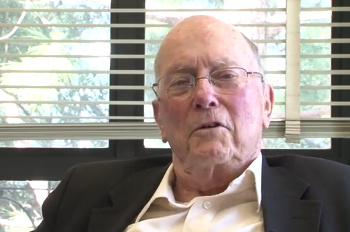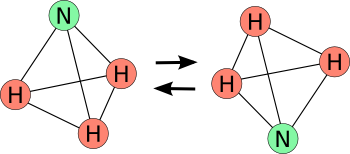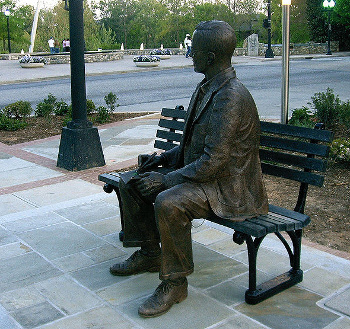Charles H. Townes (1915–2015)
February 5, 2015
Nobel laureate,
Charles H. Townes, was born on July 28, 1915, just two years after publication of the
Bohr atomic model in 1913. This first explanation of the
energy levels of
electrons in
atoms, improved over
decades by refinements in
quantum theory and
laboratory experiments, was an essential element in Townes' conception of the
maser, the
microwave analog of the
laser, in 1951, and the subsequent demonstration of a working maser in 1954. Charles Townes died Tuesday of last week, January 27, 2015, at age ninety-nine.[1-8] He was in failing
health, and he died in an
ambulance on his way to
Oakland hospital.[2-3,6-7]

Charles H. Townes (1915–2015) in his University of California, Berkeley, office at the time of his ninety-ninth birthday in 2014.
(Still image from a YouTube video.)
Charles Townes was born in
Greenville, South Carolina, on July 28, 1915, the son of an
attorney, Henry Keith Townes. His
middle name, "Hard," derives from the
maiden name of his
mother, Ellen (Hard) Townes. His
family lived on a small
farm, and one of his
hobbies was collecting
butterflies.[6] His early
education was in the Greenville
public school system. His
precocity was established by his
summa cum laude graduation in 1935 from
Furman University with a
Bachelor of Science degree in
physics and a
Bachelor of Arts degree in
modern languages.[1,2]
As he reported for his
Nobel Prize biography, Townes was attracted to physics after his first course in that subject during his
sophomore year in
college because of its "beautifully
logical structure."[1,6] He also had an interest in
natural history, serving as
curator of the Furman
museum and working summers as a
specimen collector for Furman's
biology camp. However, he didn't pursue a
career in
entomology, since he thought that he would live under his
brother's shadow. His brother, Henry Keith Townes Jr., was a founder of the
American Entomological Institute.[6] While at college, Townes was a member of the staff of the college
newspaper, the
swimming team, and the
football band.[1-2]
Since physics was not a standard major at Furman, Townes learned mostly by self-study as an
upperclassman.[8] Just a year after college graduation, Townes completed a
Master of Arts degree in physics at
Duke University. He then went on to the
California Institute of Technology, receiving a
Ph.D. degree in 1939. The topic of his
Ph.D. dissertation was
isotope separation and
nuclear spins.[1-2,6] Townes was a member of the technical staff of
Bell Labs through
World War II, where he developed
radar systems.[1-2]
Townes was somewhat disappointed at not being able to secure an
academic position right after his Ph.D., instead working in the
industrial research environment of
Bell Labs. Townes credited the
engineering environment of Bell Labs, however, as a useful training ground for his subsequent
research.[6] Experience gained with the microwave
radio frequency sources and
detector of radar systems allowed Townes to shift his research focus to
spectroscopy.
Townes left Bell Labs in 1947, and he then joined the faculty at nearby
Columbia University, where he continued research in microwave physics. At Columbia, Townes and his
students used microwaves to study the structure of
nuclei,
atoms, and
molecules.[1] As a
spectroscopist, he faced the problem that microwave sources of the time had low
intensity.[2]
It was while he was at Columbia, in 1951, that Townes got the idea for a maser, a
proof-of-principle coherent electromagnetic wave source that would eventually evolve into the laser. He chose
ammonia gas, a somewhat difficult
material to work with, as the
optical medium. This choice was driven by a favorable
energy transition in that molecule.

The nitrogen atoms in ammonia molecules oscillate through the plane formed by the hydrogen atoms.
(Illustration by the author using Inkscape.)
As can be seen in the figure, above, the
nitrogen atoms in ammonia oscillate from a position above the
plane formed by the three
hydrogen atoms to one below the plane. These two molecular configurations have very slightly different
energies, since the
wave functions of the hydrogen and nitrogen atoms are not
symmetrical. This energy difference corresponds to the microwave frequency, 23.87
GHz, which is in the frequency range used for such things as
satellite communication.
Maser is an
acronym for "microwave amplification by stimulated emission of radiation," while the later laser is named for "light amplification by stimulated emission of radiation." The laser idea was formalized by Townes and his
colleague and
brother-in-law,
Arthur Schawlow, who was a
professor at
Stanford University at the time, in a joint
publication in 1958 on "optical masers," as they were first named.
Inspiration comes to
scientists at odd times. This is a
corollary to the
theorem that you can't schedule
inventions. As a young
physicist of age 35, Townes was in
Washington, D.C., as the
chairman of a meeting of a
US Navy committee whose purpose was the development of shorter
wavelength microwaves. Away from the meeting room, Townes sat alone on a
park bench when the inspiration for the maser came to him.[2,6]

Inventions are created by individuals, not by committees, as Townes' invention of the maser demonstrates.
Charles Townes statue facing Falls Park on the Reedy River in Greenville, South Carolina
(Via Wikimedia Commons.)
The problem that Townes solved was how to
excite molecules without
decomposing them.
Heating will induce
molecular vibration, but too much heating will destroy molecules. Townes reasoned that a momentary flash of intense
light would excite the molecules without destroying them. As Townes later reported, "... I took out a piece of paper and just scratched it out," concluding, "Hey, this looks like it might work."[6] Townes, who was strongly
religious, believed that this "
revelation" was a like a gift from
God.[6]
Back at Columbia,
Isidore Rabi, who was head of the physics department, believed that the maser would never work.[6-7] Townes persisted in his research, which was his prerogative since he had
tenure.[7] When Townes and his students built the first maser, Rabi immediately apologized to Townes.[7] As Townes told the
IEEE Spectrum in an
interview,
“Disagreement is often important in the scientific process and calls for self-examination... but it doesn't usually disturb me, although in a few cases I remember it being a nuisance.”[8]
In 1958, four years after the demonstration of the maser, Townes and Schawlow devised an "optical maser" in which
mirrors reflected light within a gas-filled
cavity. An example of this is the
helium-neon laser that was ubiquitous before the creation of
semiconductor lasers. Since Townes was busy as director of research for the
nonprofit Institute for Defense Analyses, he wasn't able to follow up with
experiments on lasers.
Theodore Maiman achieved laser action in a
chromium-doped piece of
aluminum oxide crystal (a.k.a.,
ruby) at
Hughes Research Labs on May 16, 1960. I wrote about the 50th anniversary of the laser in an
earlier article (Fifty Years of Lasers, June 8, 2010).
Townes jumped from one specialty area to another about every
decade. He worked on radar in the 1940s, on the maser in the 1950s, and on the laser in the 1960s. Townes once said that “Once a field is well established, I don't feel the need to do it any more.”[8] That's why he shifted fields again in the 1970s to do
astronomy at the
University of California, Berkeley. At Berkeley, Townes developed
optical interferometry to combine signals from several
telescopes to
synthesize a larger telescope. With
William “Jack” Welch, he detected ammonia and water in
interstellar space.[2,5,7]
Townes was also involved in the first measurement of the
mass of the
Milky Way's central
black hole.[5,7] One other interesting research program that Townes undertook was a search for
infrared light signals from
extraterrestrial civilizations.[2,6] Townes served, also, as a
consultant to the
Apollo program.[7] Townes was a founding member of the
JASON group that gave advice to the US
military on
defense technologies.[4] Townes was an advocate of
banning nuclear testing.[2, 4]
Townes was a religious man, a member of the
First Congregational Church of Berkeley, and he saw no problem with the coexistence of
science and religious belief.[2]
Reinhard Genzel, director of the
Max Planck Institute for Extraterrestrial Physics (Garching, Germany), is quoted by
NPR as saying, "He really was one of these rare people who could be a deeply thinking research scientist and yet, at the same time, be a deeply devout
Christian." At his award of the 2005
Templeton Prize, Townes wrote,
“My own view is that, while science and religion may seem different, they have many similarities, and should interact and enlighten each other... Science tries to understand what our universe is like and how it works, including us humans. Religion is aimed at understanding the purpose and meaning of our universe, including our own lives. If the universe has a purpose or meaning, this must be reflected in its structure and functioning, and hence in science."[2,7]
Townes donated half of the $1.5 million Templeton Prize to Furman University, and the rest to church-based
charities.[6]
Townes was awarded the 1964
Nobel Prize in Physics, which he shared with
Aleksandr M. Prokhorov and
Nicolai G. Basov, who independently invented the maser.[2,4-5] More than a dozen Nobel Prizes have been awarded for laser research, including the 1981 Nobel Prize in Physics awarded to Arthur Schawlow for work in laser spectroscopy.[2,6] Townes was a member of the
National Academy of Sciences, a member and former
president of the
American Physical Society, an inductee of the
National Inventors Hall of Fame, and a foreign member of the
Royal Society and the
Russian Academy of Sciences.[2,5]
Among his many honors, Townes was awarded the
National Medal of Science, and the
Medal of Honor of the
Institute of Electrical and Electronics Engineers.[2,5] He received
honorary degrees from 25 colleges and universities,[2,5] and he was a life member of the California Institute of Technology
Board of Trustees.[5]
Townes admitted to the IEEE Spectrum in 1991 that “Physics is my only permanent
hobby.”[8] He worked regularly at his Berkeley office through age 98.[2] Up to age 76, at least, he worked long hours, including nights and most Saturdays, but never Sundays.[8]
Fellow Nobel Laureate,
Ahmed H. Zewail, a
chemist at Caltech, said that Townes was "one of the great physicists of the
20th century."[6] Reinhard Genzel said that
"He was one of the most important experimental physicists of the last century. To those who knew him as colleagues or students, he was a role model, a wonderful mentor and a deeply admired person. His strength was his curiosity and his unshakable optimism, based on his deep Christian spirituality."[2]
Townes is survived by Frances Hildreth Townes, his
wife of 74 years, four
daughters and six
grandchildren.[7]
References:
- "Charles H. Townes - Biographical, The Nobel Prize in Physics 1964, Nobelprize.org (Nobel Media AB, 2014).
- Robert Sanders, "Nobel laureate and laser inventor Charles Townes dies at 99," University of California, Berkeley, Press Release, January 27, 2015.
- A Life Dedicated to Science - Nobel laureate and laser inventor Charles Townes dies at 99, University of California, Berkeley, Physics Department Web Site, January 27, 2015.
- Geoff Brumfiel, "Charles Townes, Laser Pioneer, Black Hole Discoverer, Dies At 99," NPR - All Things Considered, January 28, 2015.
- Kathy Svitil, "Charles H. Townes 1915–2015," California Institute of Technology Press Release, January 28, 2015
- Charles Piller and Thomas H. Maugh II, "Charles Townes, physicist who invented the laser, dies at 99," LA Times, January 28, 2015.
- Iain Thomson, "Charles Townes, inventor of the laser and friend to both science and religion, dies," The Register (UK), January 29, 2015.
- Tekla Perry, "Maser Man Charles Townes Dead At 99," IEEE Spectrum, January 28, 2015.
Permanent Link to this article
Linked Keywords: Nobel laureate; Charles H. Townes; Bohr atomic model; energy level; electron; atom; decade; quantum mechanics; quantum theory; laboratory; experiment; maser; microwave; analogy; analog; laser; health; ambulance; Oakland; hospital; University of California, Berkeley; YouTube video; Greenville, South Carolina; lawyer; attorney; middle name; maiden name; mother; family; farm; hobby; butterfly; education; public school system; child prodigy; precocity; Latin honor; summa cum laude; graduation; Furman University; Bachelor of Science degree; physics; Bachelor of Arts degree; modern language; Nobel Prize; biography; sophomore year; college; logic; logical; natural history; curator; museum; zoological specimen; biology; summer camp; career; entomology; sibling; brother; American Entomological Institute; newspaper; swimming; american football; marching band; upperclassman; Master of Arts degree; Duke University; California Institute of Technology; Doctor of Philosophy; Ph.D. degree; Ph.D. dissertation; isotope separation; nuclear spin; Bell Labs; World War II; radar system; academia; academic; research and development; industrial research; engineering; research; radio frequency; detector; spectroscopy; Columbia University; postgraduate education; student; atomic nucleus; nuclei; atom; molecule; spectroscopist; intensity; proof of concept; proof-of-principle; coherence; coherent; electromagnetic radiation; electromagnetic wave; ammonia gas; material; optics; optical; energy level diagram; energy transition; nitrogen; hydrogen; Inkscape; plane; energy; wave function; symmetry; symmetrical; GHz; satellite communication; acronym; collegiality; colleague; brother-in-law; Arthur Schawlow; professor; Stanford University; academic publishing; publication; scientist; corollary; theorem; invention; physicist; Washington, D.C.; chairman; United States Navy; committee; wavelength; park bench; Falls Park on the Reedy; Reedy River; Wikimedia Commons; excited state; excite; chemical decomposition; heat; molecular vibration; light; religion; religious; revelation; God; Isidor Isaac Rabi; tenure; IEEE Spectrum; interview; mirror; reflection; reflected; optical cavity; helium-neon laser; laser diode; semiconductor laser; nonprofit organization; Institute for Defense Analyses; Theodore Maiman; chromium; aluminum oxide; ruby; Hughes Research Labs; astronomy; optical interferometry; telescope; aperture synthesis; synthesize; William “Jack” Welch; interstellar medium; interstellar space; mass; Milky Way; black hole; infrared light; extraterrestrial civilization; consultant; Apollo program; JASON advisory group; military; defense; technology; Comprehensive Nuclear-Test-Ban Treaty; First Congregational Church of Berkeley; science; Reinhard Genzel; Max Planck Institute for Extraterrestrial Physics (Garching, Germany); NPR; Christian; Templeton Prize; universe; human; charitable organization; charity; Nobel Prize in Physics; Aleksandr M. Prokhorov; Nicolai G. Basov; National Academy of Sciences; president; American Physical Society; National Inventors Hall of Fame; Royal Society; Russian Academy of Sciences; National Medal of Science; IEEE Medal of Honor; Institute of Electrical and Electronics Engineers; honorary degree; Board of Trustees; Ahmed H. Zewail; chemist; 20th century; mentor; wife; daughter; grandchild; grandchildren.